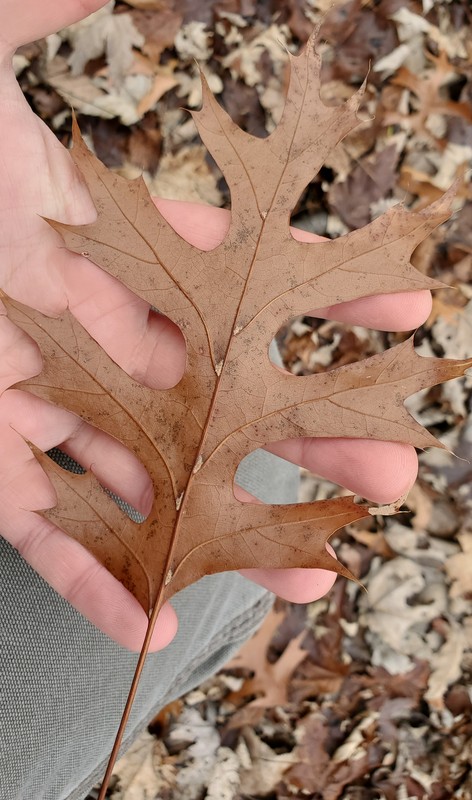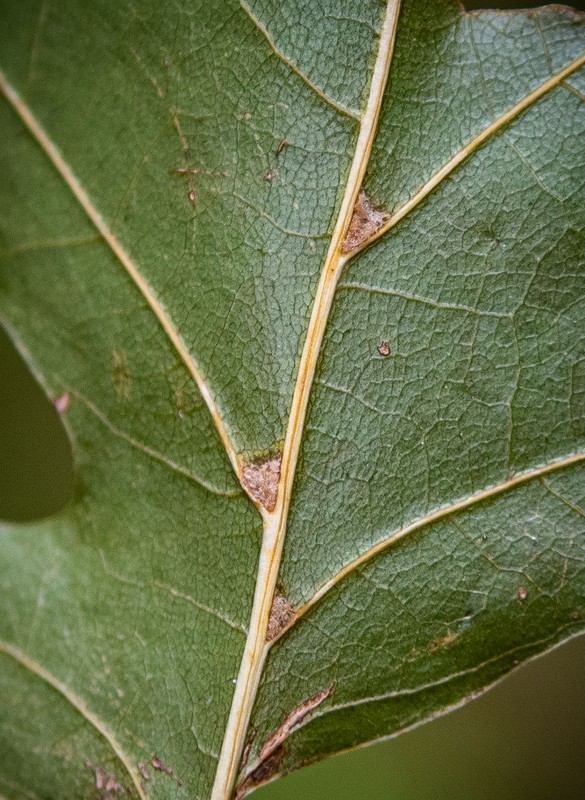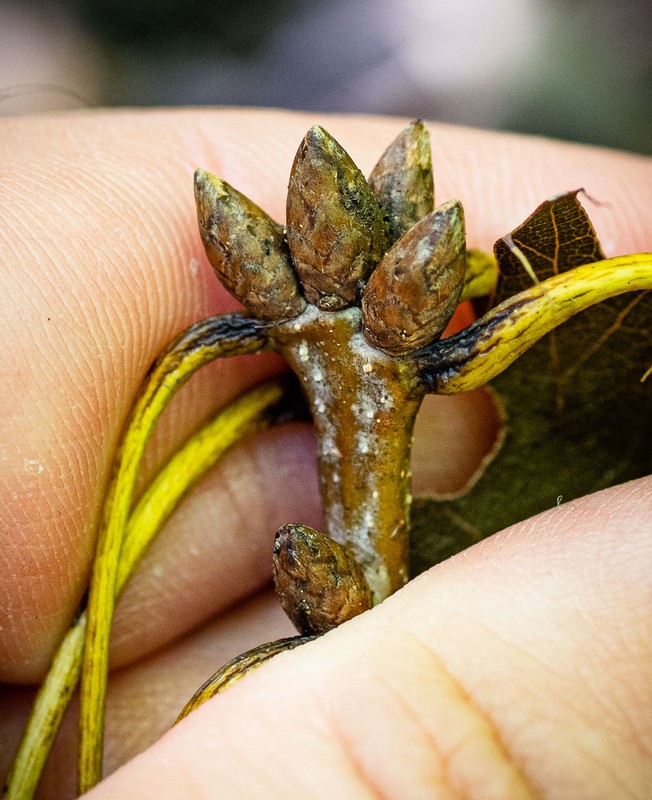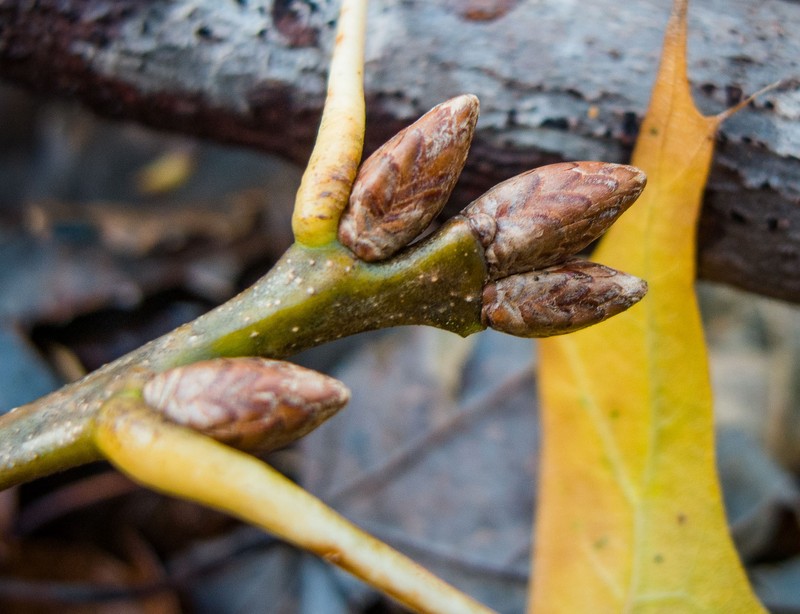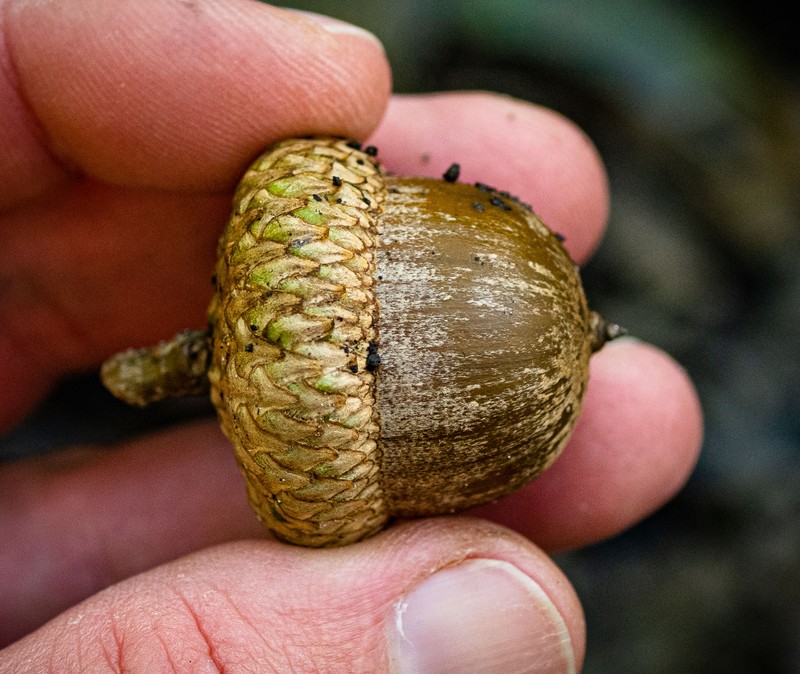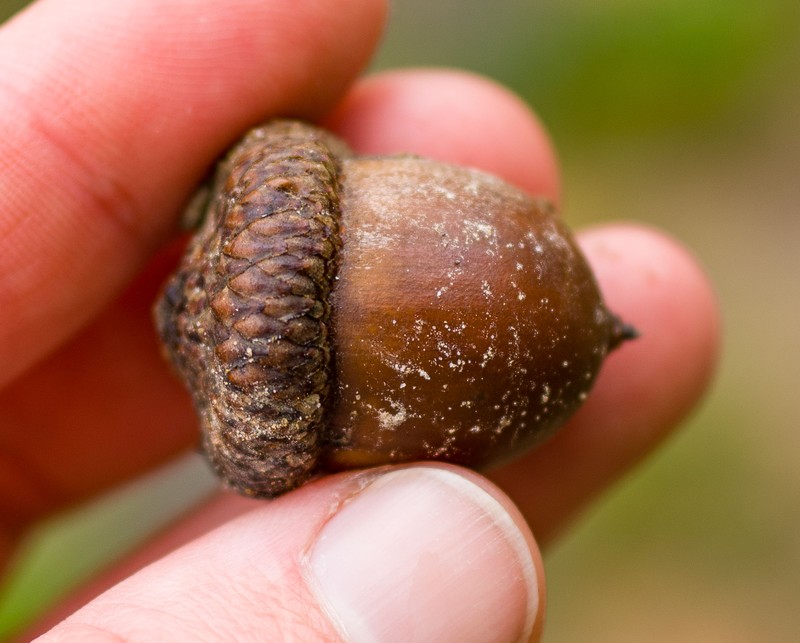Shumard Oak
Quercus shumardii var. shumardii None
- Class
- Dicotyledoneae (Dicots)
- Family
- Fagaceae (Beech Family)
- State Protection
- Endangered
Listed as Endangered by New York State: in imminent danger of extirpation in New York. For animals, taking, importation, transportation, or possession is prohibited, except under license or permit. For plants, removal or damage without the consent of the landowner is prohibited.
- Federal Protection
- Not Listed
- State Conservation Status Rank
- S1
Critically Imperiled in New York - Especially vulnerable to disappearing from New York due to extreme rarity or other factors; typically 5 or fewer populations or locations in New York, very few individuals, very restricted range, very few remaining acres (or miles of stream), and/or very steep declines.
- Global Conservation Status Rank
- G5T5
Secure globally - Both the species as a whole and the subspecies/variety are common in the world; widespread and abundant (but may be rare in some parts of its range).
Summary
Did you know?
Samuel Botsford Buckley was the assistant state geologist of Texas in 1860 when he named this oak in honor of Benjamin Franklin Shumard, the Texas state geologist at the time. Both men had roots in the East. Buckley grew up in the Town of Torrey (not named for botanist John Torrey), New York, in Yates County and Shumard was from Lancaster, Pennsylvania.
State Ranking Justification
There are three existing populations but they are small with fewer than 50 trees each. Trees were first discovered in 1999 and there are no historical occurrences.
Short-term Trends
No short-term trends have been established.
Long-term Trends
No long-term trends have been established.
Conservation and Management
Threats
Utility, recreational, and transportation construction may threaten one population. Some invasive species are present that may impact regeneration. One population has had logging and ditching take place nearby.
Conservation Strategies and Management Practices
Protect all trees from the effects of nearby construction or development. Suppress invasive species within the area.
Research Needs
There are no known research needs at this time.
Habitat
Habitat
In New York Shumard Oak has been reported from seasonally flooded swamp forests dominated by maples and other oak species (New York Natural Heritage Species 2013). Rare in moist to wet woods (Rhoads and Block 2007). Mesic slopes and bottoms, stream banks and poorly drained uplands (FNA 1997). Chiefly in moist, lowland soil (Gleason and Cronquist 1991). Rich woods, bottoms, or calcareous slopes (Fernald 1950).
Associated Ecological Communities
- Red maple-hardwood swamp*
(guide)
A hardwood swamp that occurs in poorly drained depressions, usually on inorganic soils. Red maple is usually the most abundant canopy tree, but it can also be codominant with white, green, or black ash; white or slippery elm; yellow birch; and swamp white oak.
- Silver maple-ash swamp*
(guide)
A hardwood basin swamp that typically occurs in poorly-drained depressions or along the borders of large lakes, and less frequently in poorly drained soils along rivers. These sites are characterized by uniformly wet conditions with minimal seasonal fluctuations in water levels. The dominant trees are usually silver maple and green ash.
* probable association but not confirmed.
Associated Species
- Acalypha rhomboidea (common three-seeded-Mercury)
- Acer nigrum (black maple)
- Acer rubrum
- Acer saccharinum (silver maple)
- Acer x freemanii
- Agrimonia gryposepala (common agrimony)
- Arisaema triphyllum
- Athyrium filix-femina
- Atrichum undulatum
- Boehmeria cylindrica (false nettle)
- carex gynandra
- Carex bromoides
- Carex gracillima (graceful sedge)
- Carex grayi (Gray's sedge)
- Carex lupulina (hop sedge)
- Carex radiata (narrow-leaved upland star sedge)
- Carex tribuloides
- Carpinus caroliniana
- Carya ovata
- Cinna arundinacea (stout wood-reed)
- Circaea lutetiana
- Cornus amomum
- Cornus racemosa (gray dogwood, red-panicled dogwood)
- Dioscorea villosa (wild yam)
- Elymus virginicus
- Epilobium coloratum (eastern willow-herb)
- Erechtites hieraciifolia
- Euonymus obovata
- Fissidens adianthoides
- Fraxinus pennsylvanica (green ash)
- Geum canadense (white avens)
- Geum rivale (purple avens, water avens)
- Glyceria striata (fowl manna grass)
- Juglans cinerea (butternut)
- Laportea canadensis (wood-nettle)
- Lindera benzoin (spicebush)
- Lysimachia ciliata (fringed-loosestrife)
- Lysimachia nummularia (moneywort, creeping-Jenny)
- Maianthemum stellatum (starry Solomon's-seal)
- Mentha arvensis (field mint)
- Onoclea sensibilis (sensitive fern)
- Ostrya virginiana (hop hornbeam, ironwood)
- Persicaria pensylvanica (Pennsylvania smartweed)
- Persicaria virginiana (jumpseed)
- Phragmites australis ssp. australis
- Podophyllum peltatum (may-apple)
- Populus deltoides
- Prunus serotina
- Pyrus communis (common pear)
- Quercus alba (white oak)
- Quercus bicolor (swamp white oak)
- Quercus macrocarpa (bur oak)
- Quercus palustris (pin oak)
- Quercus rubra (northern red oak)
- Rosa palustris (swamp rose)
- Rubus idaeus ssp. idaeus (European red raspberry)
- Salix atrocinerea
- Salix x rubens
- Sium suave (hemlock water-parsnip)
- Solidago flexicaulis (zig-zag goldenrod)
- Solidago rugosa
- Symphyotrichum lanceolatum
- Symphyotrichum urophyllum (arrow-leaved-aster)
- Teucrium canadense (American germander)
- Thalictrum pubescens (tall meadow-rue)
- Tilia americana
- Toxicodendron radicans
- Triosteum perfoliatum (perfoliate-leaved horse-gentian)
- Ulmus americana (American elm)
- Vitis riparia (river grape, frost grape)
- Zanthoxylum americanum (prickly-ash)
Range
New York State Distribution
In New York Shumard Oak is known only from Niagara County.
Global Distribution
Shumard Oak is most common in the lower Mississippi and Ohio River valleys, and in the southeast, with isolated records north to Michigan, New York, Pennsylvania and Maryland.
Identification Comments
General Description
Quercus shumardii var schumardii is a native, deciduous tree growing up to 35 m tall. Its bark is gray-brown to dark brown, shallowly fissured with scaly or light-colored flat ridges and pinkish inner bark. The twigs are smooth, hairless (glabrous) and gray to light brown. The terminal buds are glabrous, gray to grayish brown, egg-shaped (ovoid) or broadly ellipsoid, 4 to 8 mm long, and often noticeably 5-angled in cross section. Leaves have a long (20 to 60 mm) smooth petiole, a broadly elliptic to obovate shape and are 100-200 mm long by 60 to 150 mm wide, with an obtuse to truncate or occasionally acute base. The leaf margins are 5 to 9-lobed with 15 to 50 awns. The lobes are oblong or expanded towards the top (distally) and have pointed tips. The leaves have glossy, glabrous upper surface and undersides that are also glabrous except for prominent axillary tufts of densely matted wooly hairs (tomentum) The secondary veins are raised on both leaf surfaces. The fruits are acorns, maturing biennially, and have saucer to cup-shaped caps that cover about 1/4 of the nut. The cap's outer surface is glabrous or puberulent, the inner surface is light-brown to red-brown, glabrous or with ring of pubescence around scar. The nuts are egg-shaped (ovoid) to oblong, occasionally subglobose, and 14 to 30 mm by 10 to 20 mm (FNA 1997).
Identifying Characteristics
Quercus shumardii var schumardii is a native, deciduous tree growing up to 35 m tall. Its bark is gray-brown to dark brown, shallowly fissured with scaly or light-colored flat ridges and pinkish inner bark. The twigs are smooth, hairless (glabrous) and gray to light brown. The terminal buds are glabrous, gray to grayish brown, egg-shaped (ovoid) or broadly ellipsoid, 4 to 8 mm long, and often noticeably 5-angled in cross section. Leaves have a long (20 to 60 mm) smooth stalk (petiole), a broadly elliptic to obovate shape and are 100-200 mm long by 60 to 150 mm wide with an obtuse to truncate or occasional acute base. The leaf margins are 5 to 9 lobed with 15 to 50 awns. The lobes are oblong or expanded towards the top (distally) and have pointed tips. The leaves have glossy, glabrous upper surface and undersides (abaxially) that are also glabrous except for prominent axillary tufts of densely matted wooly hairs (tomentum), the secondary veins are raised on both surfaces. The fruits are acorns that mature biennially, and have saucer to cup-shaped caps that cover 1/4 of the nut. The cap's outer surface is glabrous or puberulent, the inner surface is light-brown to red-brown, glabrous or with ring of pubescence around scar. The cap scales often have pale margins, their tips are tightly appressed, and obtuse or acute. The nuts are egg-shaped (ovoid) to oblong, occasionally subglobose, and 14 to 30 mm by 10 to 20 mm. (FNA 1997)
Best Life Stage for Proper Identification
Shumard's oak is best identified through the examination of its leaves and mature acorns with an accompanying habitat description. Terminal branch sections with intact winter buds should also be examined if possible.
Similar Species
Shumard Oak is similar in appearance to northern red, black, and scarlet oaks (Q. rubra, Q. velutina, and Q. coccinea). Black and Scarlet Oaks can be separated by their uniformly pubescent terminal buds,while Northern Red Oak typically has shallower leaf sinuses than does Shumard oak and lack's the latter's raised leaf veins and conscpicuous axillary hair tufts. In addition the fruits vary among the species. Scarlet Oak acorns are enclosed for 1/2 of their height or less in a thick cup-shaped cap with lustrous scales. Black Oak has acorns enclosed for 1/3 or less in a bowl shaped-cup of thin, loose, dull, wooly scales. Northern red oak has acorns with flat, saucer-shaped, beret-like caps enclosing only 1/4 or less of the acorn. The acorns of Shumard oak have caps with thick walls (over 1.5 mm in cross section) and are saucer to cup-shaped enclosing more than 1/4 of the nut (FNA 1997, Reznicek et al 2011).
Best Time to See
Shumard's oak can be seen year round in vegetative form. The leaves are typically present from mid-May and persist until late October. The mature acorns fruits are present every two years from early August through late October.
- Vegetative
- Fruiting
The time of year you would expect to find Shumard Oak vegetative and fruiting in New York.
Shumard Oak Images
Taxonomy
Shumard Oak
Quercus shumardii var. shumardii None
- Kingdom Plantae
- Phylum Anthophyta
- Class Dicotyledoneae
(Dicots)
- Order Fagales
- Family Fagaceae (Beech Family)
- Order Fagales
- Class Dicotyledoneae
(Dicots)
- Phylum Anthophyta
Additional Resources
Best Identification Reference
Flora of North America Editorial Committee. 1997. Flora of North America, vol. 3 Magnoliophyta: Magnoliidae and Hamamelidae. Oxford University Press, New York.
Other References
Fernald, M. L. 1950. Gray's manual of botany. 8th edition. Corrected printing (1970). D. Van Nostrand Company, New York. 1632 pp.
Gleason, Henry A. and A. Cronquist. 1991. Manual of Vascular Plants of Northeastern United States and Adjacent Canada. The New York Botanical Garden, Bronx, New York. 910 pp.
Holmgren, Noel. 1998. The Illustrated Companion to Gleason and Cronquist's Manual. Illustrations of the Vascular Plants of Northeastern United States and Adjacent Canada. The New York Botanical Garden, Bronx, New York.
Little, E.L., Jr. 1979. Checklist of United States trees (native and naturalized). Agriculture Handbook No. 541. U.S. Forest Service, Washington, D.C. 375 pp.
MICHIGAN FLORA ONLINE. A. A. Reznicek, E. G. Voss, & B. S. Walters. February 2011. University of Michigan. Web. Accessed March 8, 2013. http://www.michiganflora.net/
New York Natural Heritage Program. 2024. New York Natural Heritage Program Databases. Albany, NY.
Rhoads, Ann F. and Timothy A. Block. 2005. Trees of Pennsylvania. A Complete Reference Guide. University of Pennsylvania Press, Philadelphia, PA.
Weldy, T. and D. Werier. 2010. New York flora atlas. [S.M. Landry, K.N. Campbell, and L.D. Mabe (original application development), Florida Center for Community Design and Research http://www.fccdr.usf.edu/. University of South Florida http://www.usf.edu/]. New York Flora Association http://newyork.plantatlas.usf.edu/, Albany, New York
Links
About This Guide
This guide was authored by: Richard M. Ring
Information for this guide was last updated on: November 23, 2022
Please cite this page as:
New York Natural Heritage Program. 2024.
Online Conservation Guide for
Quercus shumardii var. shumardii.
Available from: https://guides.nynhp.org/shumard-oak/.
Accessed July 27, 2024.
